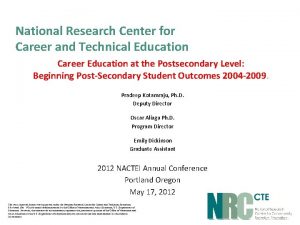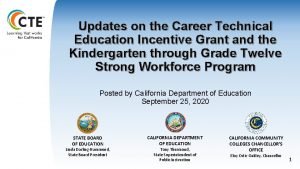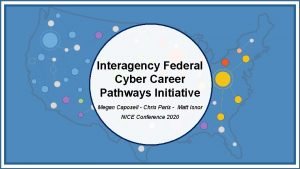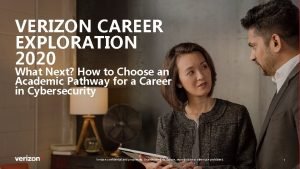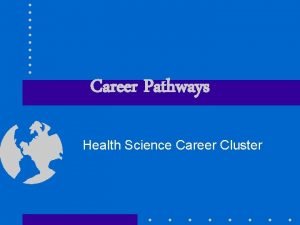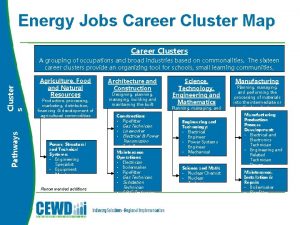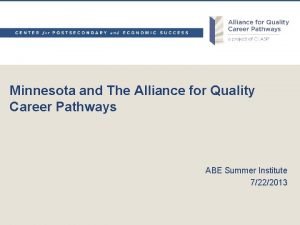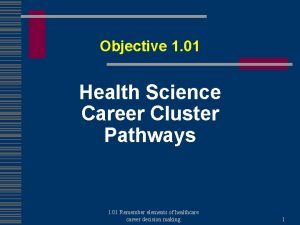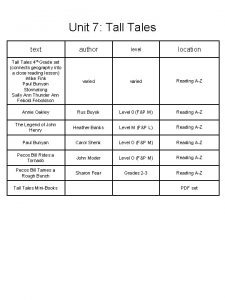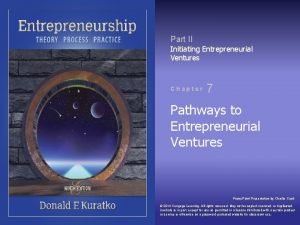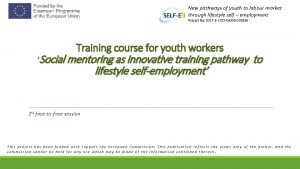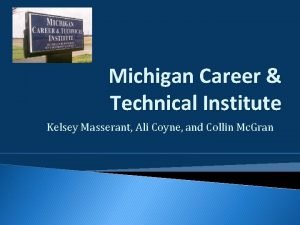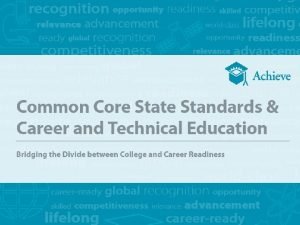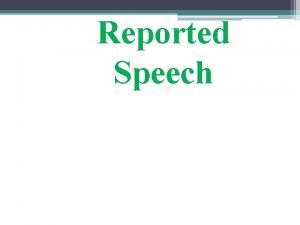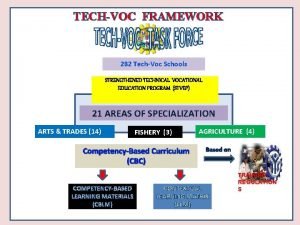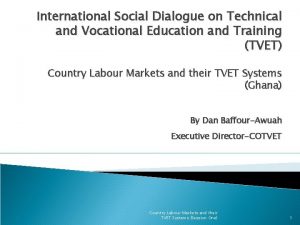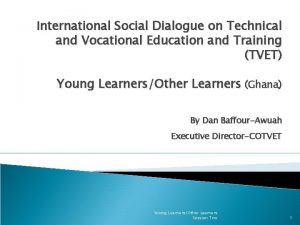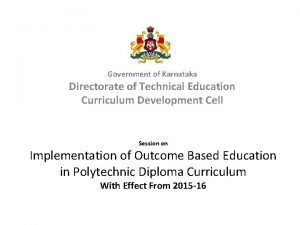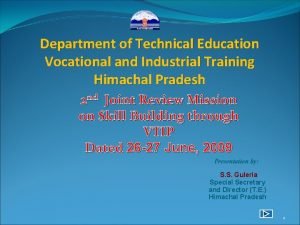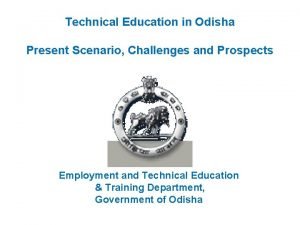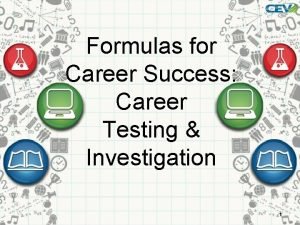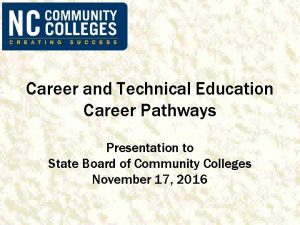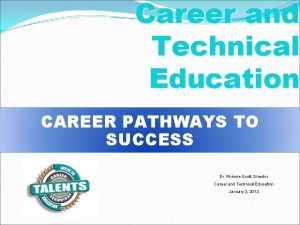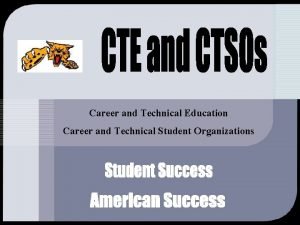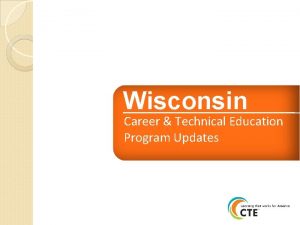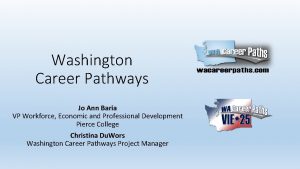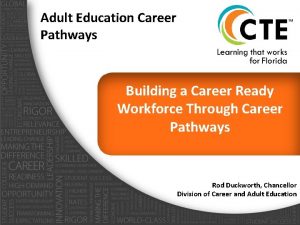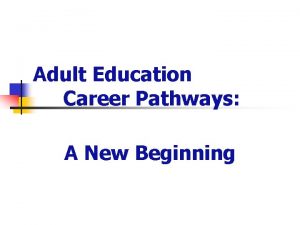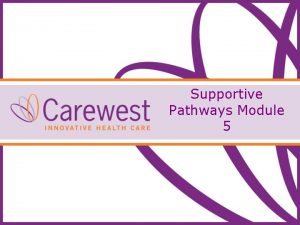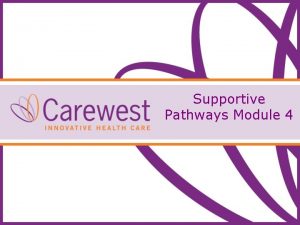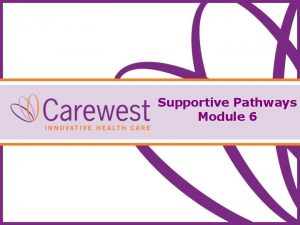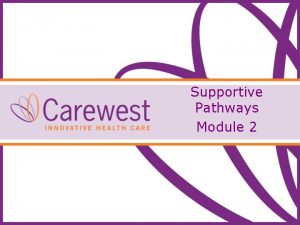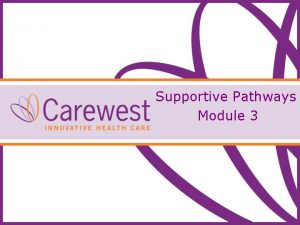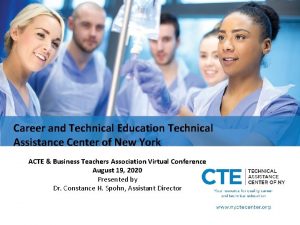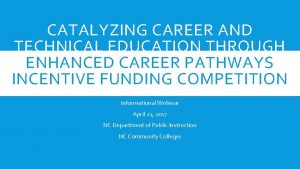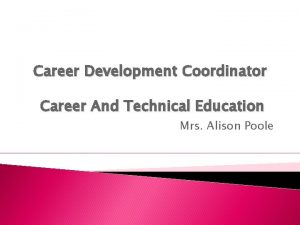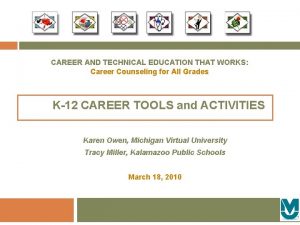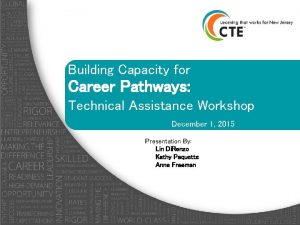Career Pathways The New Career Technical Education Ann
















































- Slides: 48

Career Pathways: The New Career Technical Education Ann Benson Education Consultant 405 -743 -2919 gben@brightok. net 1

Essential Questions n How are we doing and why are we getting involved in using career clusters, career pathways and programs of study? 2

2006 HSTW CTE Students: Percentage Meeting Reading Performance Goal-279 3

2006 HSTW CTE Students: Percentage Meeting Mathematics Performance Goal-297 4

2006 HSTW CTE Students: Percentage Meeting Science Performance Goal-299 5

2006 HSTW CTE Students: Percentage Having Intensive Work-based Learning Experiences 6

Percent of Students Who Take Remedial Courses n 63% at two-year institutions n 40% at four-year institutions The Bridge Project Stanford University 7

How Hiring Practices Will Change n n 28% will reduce hiring those with only a high school diploma 49. 5% will increase two-year college graduates Almost 60% will increase their hires of four -year college graduates 42% will increase their hires of postgraduates within next five years The Conference Board 8

Vocational Education vs. Career and Technical Education Vocational Education “Then” Career and Technical Education “Now” For Some”Students For All Students For a Few Jobs For All Careers 6 to 7 “Program Areas” 16 Clusters – 81 Pathways In Lieu of Academics Aligns and Supports Academics High School Focused High School and College Partnerships 9

A bit of history … n n U. S. Department of Education National Association of State Directors of Career Technical Education National Advisory Committees Cluster Leaders 10

Career Clusters “An organizing tool defining CTE using 16 broad clusters of occupations and 81 pathways with validated standards that ensure opportunities for all students regardless of their career goals and interests. “ 11

Career Pathway “ A career pathway is a coherent, articulated sequence of rigorous academic and career related courses, commencing in ninth grade and leading to an associate degree, and/or an industry-recognized certificate or licensure, and/or a baccalaureate and beyond. “ 12

Programs of Study (Pathways) As Defined in Perkins 13

Perkins – “Programs of Study” “State approved programs, which may be adopted by local education agencies and postsecondary institutions to be offered as an option to students when planning for and completing future coursework, for career and technical content areas. “ 14

Perkins – “Programs of Study” 1. Incorporate secondary education and postsecondary education elements; 15

Perkins – “Programs of Study” 2. Include coherent and rigorous content aligned with challenging academic standards and relevant career and technical content in a coordinated, nonduplicative progression of courses that align secondary education with postsecondary education to adequately prepare students to succeed in postsecondary education; 16

Perkins – “Programs of Study” 3. May include the opportunity for secondary education students to participate in dual or concurrent enrollment programs or other ways to acquire postsecondary education credits; and 17

Perkins – “Programs of Study” 4. Lead to an industry-recognized credential or certificate at the postsecondary level, or an associate or baccalaureate degree. 18

16 Career Clusters 19

So where do Career Clusters fit in? What are they? n n Career Clusters are groupings of occupations and industries These groupings are used as an organizing tool for: n n n Curriculum Design Instructional + Guidance Model Seamless Transition 20

What about Career Pathways? n A Career Pathway represents a grouping of occupations within a cluster based on commonalities 21

What are the Programs of Study? n n A sequenced listing of courses, both academic and CTE/degree major, that connects student’s high school and postsecondary educational experiences A set of course descriptions for the CTE/degree major courses based on knowledge and skill statements 22

www. careerclusters. org 23

24

25

26

27

28

29

30

31

32

Our Rules for Development-POS We Recommend Them for Your Use! 1. 2. 3. 4. 5. 6. POS are only samples Template is set-No Tinkering! Coursework must be rigorous enough to ensure postsecondary success Course titles are only examples CTE/degree major courses must be based on K & S statements POS are only samples 33

34

35

36

37

38

The Most Important Aspects of Plans/Programs of Study Cluster Foundation Knowledge and Skills n Career Pathway Knowledge and Skills n 39

Structure of Foundation Knowledge and Skills n Three components n Overarching Knowledge and Skill Statement (K & S Statement) n One or more Performance Elements for each K&S Statement n One or more Measurement Criteria/Topics for each Performance Element 40

POS Checklist Are both academic and degree major courses included? þ Are both secondary and postsecondary courses included? þ Does coursework reflect the K & S? þ Do courses represent a sequence of instruction that leads to a degree, certificate or credential? þ 41

POS Checklist, con’t. Do courses represent a coherent and rigorous program of studies? þ Have courses been cross-referenced against state and national standards? þ Does completion of the high school courses ensure success at the postsecondary level? þ Does the high school plan reflect opportunities for postsecondary enrollment? þ 42

What about Local Implementation? n n n What do Programs of Study look like and how are they developed for the local level? Can I still teach all of the same courses? How will I know what to teach? 43

Implementation of pathways organized around the 16 clusters provides: u Consistency for better data (results) and shared opportunities for development u Articulation within and between states u Employer and postsecondary validated standards Opportunities for “all” students u A “place” for all career goals and u interests 44

Cluster Approach to Addressing Educational Redesign n Strategy to organize instruction and student experiences around career themes (Focus on an industry cluster of related occupations) Incorporates existing school reform strategies (career academies, career pathways, small learning communities, Tech Prep) Connects to business and higher education 45

Key Points of Colorado Implementation n WHAT? Every student will follow a pathway that leads to career success. HOW? Through seamless programs of study fostering academic and technical achievement. WHY? To develop a globally competitive workforce for Colorado. 46

QUESTIONS? ? 47

If I can provide you with any assistance, please contact: Ann Benson 405 -743 -2919 (office) 405 -880 -5383 (cell) gben@brightok. net 48
 National research center for career and technical education
National research center for career and technical education Cteig
Cteig Cyber career pathways tool
Cyber career pathways tool Verizon career pathways
Verizon career pathways 5 healthcare career pathways
5 healthcare career pathways 5 health care career pathways
5 health care career pathways Energy career cluster definition
Energy career cluster definition Quality career pathways
Quality career pathways Health science career cluster jobs
Health science career cluster jobs Wisconsin career pathways
Wisconsin career pathways Was sally ann thunder ann whirlwind a real person
Was sally ann thunder ann whirlwind a real person Carol ann duffy anne hathaway analysis
Carol ann duffy anne hathaway analysis Chapter 7: pathways to entrepreneurial ventures
Chapter 7: pathways to entrepreneurial ventures New pathways for youth jobs
New pathways for youth jobs Mcti dorms
Mcti dorms Common career technical core standards
Common career technical core standards Chassey ako
Chassey ako Yesterday evening reported speech
Yesterday evening reported speech Stvep
Stvep Technical education dialogue
Technical education dialogue Technical education dialogue
Technical education dialogue Credilab
Credilab Director of technical education hp
Director of technical education hp Odisha technical education
Odisha technical education 17 career clusters
17 career clusters Formulas for career success
Formulas for career success Hình ảnh bộ gõ cơ thể búng tay
Hình ảnh bộ gõ cơ thể búng tay Slidetodoc
Slidetodoc Bổ thể
Bổ thể Tỉ lệ cơ thể trẻ em
Tỉ lệ cơ thể trẻ em Voi kéo gỗ như thế nào
Voi kéo gỗ như thế nào Chụp phim tư thế worms-breton
Chụp phim tư thế worms-breton Hát lên người ơi alleluia
Hát lên người ơi alleluia Các môn thể thao bắt đầu bằng tiếng đua
Các môn thể thao bắt đầu bằng tiếng đua Thế nào là hệ số cao nhất
Thế nào là hệ số cao nhất Các châu lục và đại dương trên thế giới
Các châu lục và đại dương trên thế giới Công thức tính thế năng
Công thức tính thế năng Trời xanh đây là của chúng ta thể thơ
Trời xanh đây là của chúng ta thể thơ Cách giải mật thư tọa độ
Cách giải mật thư tọa độ 101012 bằng
101012 bằng Phản ứng thế ankan
Phản ứng thế ankan Các châu lục và đại dương trên thế giới
Các châu lục và đại dương trên thế giới Thể thơ truyền thống
Thể thơ truyền thống Quá trình desamine hóa có thể tạo ra
Quá trình desamine hóa có thể tạo ra Một số thể thơ truyền thống
Một số thể thơ truyền thống Cái miệng xinh xinh thế chỉ nói điều hay thôi
Cái miệng xinh xinh thế chỉ nói điều hay thôi Vẽ hình chiếu vuông góc của vật thể sau
Vẽ hình chiếu vuông góc của vật thể sau Biện pháp chống mỏi cơ
Biện pháp chống mỏi cơ đặc điểm cơ thể của người tối cổ
đặc điểm cơ thể của người tối cổ
